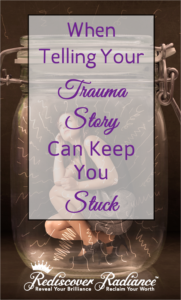If you’ve followed me for a while, you know that I’m a strong advocate for telling your trauma story. But is it always a good thing? Can telling your trauma story actually keep you stuck? Read the following true-life example and decide for yourself.
The sun bounced off the stucco tiles as it warmed the Spanish courtyard in which I stood. All around me, people with name tags huddled under the shade of palm trees in groups of two or three, chatting animatedly. The groups shifted membership every few minutes.
The introvert in me shuddered, but submitted herself to the extrovert that must take charge on such occasions. Time to get my Networking game on. After all, half the benefit of attending Big Events like this is meeting great people.
And I met some fabulous entrepreneurs that weekend; people who are my colleagues and friends to this day. Amidst all the great training we received that weekend, we shared many personal stories: client success stories; hilarious, “can-you-believe-this-happened-in-my-business” stories; and own stories about how we began doing our work in the world.
One woman, however, told a very different kind of story. I have no idea what this woman does for a living. I don’t recall if she ever told me. I honestly don’t even remember her name. What I DO remember, is that her doctor gave her Graves’ Disease. That’s the story she told, passionately and with a palpable undercurrent of hostility. Every time I saw her that weekend, whether during a break or over a meal, I overheard her telling The. Same. Exact. Story. In a universe of uplifting energy, she was a giant black hole of negativity.

Narrative Identity and Telling Your Trauma Story
Psychologist Dan McAdams defines narrative identity as “an internalized story you create about yourself — your own personal myth. Like myths, our narrative identity contains heroes and villains that help us or hold us back, major events that determine the plot, challenges overcome and suffering we have endured.” Through his research, he found two main types of stories that people tell: “redemptive stories,” which highlight the good that comes from bad situations; and “contamination stories,” which emphasize good situations ending badly. As would be expected, people who tell redemptive stories feel more driven to contribute to society, while those who tell contamination stories feel less inclined to do so. They also experience more anxiety and depression.
It’s not like every story told that weekend was all rainbows and pixie dust. People told real stories, including real struggles and even real failures. But the undercurrent of most people’s story was growth, learning from adversity, and success through the struggle. They told redemptive stories.
In contrast, Graves’ Disease Woman’s contamination story kept her stuck in negativity. It reinforced her Victim status and inspired nothing but pity. Because her story stopped with the (presumed) incompetence of a medical professional, she remained powerless. Not only that, but she continued to traumatize herself again and again, every time she told her trauma story.
To turn her contamination story into a redemptive story, all she needed to do was continue that very same story (with less hostility) and talk about how, perhaps, she’d used her condition as motivation to become an expert in clean eating to improve her health, and now teaches others to do the same. Wow, what a difference that story would have made! Empowering rather than victimizing. Inspiring admiration instead of pity.
Your trauma story isn’t over
When you’re telling your trauma story, the good news is that you have control over which stories you tell, where your story “ends,” and how you frame your experiences. It’s not about putting lipstick on a pig and pretending everything’s perfect when it isn’t. It isn’t about denying reality. The power of telling your trauma story – and whether it leads to healing or a perpetual victim status – all depends on where you “stop” the story, so to speak.
Perhaps you’re still “in” your story. Realize that, wherever you are now, it’s not the end of the story. The end has yet to be written, and guess what – you’re the one who gets to write it. The Success Principles author Jack Canfield (affiliate link) reminds us that we can’t control our circumstances – only our reactions to them.
What will your reaction be? Will you grow? Become stronger? Help others? That’s the end of your story. Up to this point, anyway.
When you’re telling your trauma story, do it for healing, not for pity or simply to complain. Tell it to help someone else. Tell it to free yourself. Let it be a redemptive story, and it won’t hold you back any longer. Instead, you will speak the truth, and the truth will set you free.
In my next post, I’ll share 3 more tips on telling your trauma story.
Do you have a trauma story you’d like to share? Feel free to leave a comment below. (This is a safe space, as all comments are moderated and negative feedback of reader comments will NOT be published.)


2 replies to "Telling Your Trauma Story Can Keep You Stuck"
[…] life to a man in the desert or drown a man in the middle of the ocean. I’ve even talked about how and when telling your trauma story can keep you stuck if you’re determined to remain a […]
[…] That’s exactly what I’ve said for years! YOU matter. Your story matters. That’s why I wrote three blog posts this year about telling your story. (Read them here, here, and here.) […]